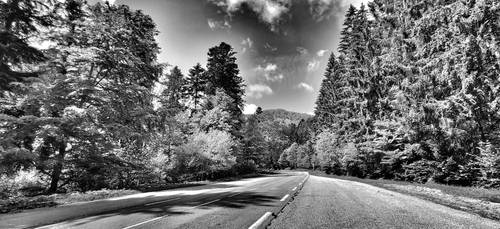ShopDreamUp AI ArtDreamUp
Deviation Actions
Description
l FaceBook l Websitel RedBubble l Twitter l
© Copyright All rights reserved Aaron Radford 2010
About
Today has been all the seasons in one hit we have had rain, sun, wind the works on the upside i was able to capture this beautiful sunset.
This photo in straight from camera only very minor Saturation adjustments made as i shoot in RAW. there is no HDR or DRI i used a Cokin ND8+ filter and a CP filter to stop me right down to allow for long exposure to capture all the amazing colours.
About sunset Colours
The intense red and orange hues of the sky at sunrise and sunset are mainly caused by scattering of sunlight by dust particles, soot particles, other solid aerosols, and liquid aerosols in the Earth's atmosphere. These enhanced red and orange colors at sunrise and sunset are mathematically explained by the Mie theory or the discrete dipole approximation. When there are no particulates in the troposphere, such as after a big rain storm, then the remaining less intense reds are explained by Rayleigh Scattering of sunlight by air molecules. Sunset colors are typically more brilliant and more intense than sunrise colors, since there are generally more particles and aerosols in the evening air than in the morning air. Nighttime air is usually cooler and less windy, which allows dust and soot particles to settle out of the atmosphere, reducing the amount of Mie Scattering at sunrise. The reduced Mie Scattering correspondingly reduces the amount of red and orange scattered light at sunrise. Sunrise color intensities can however exceed sunset's intensities when there are nighttime fires, volcanic eruptions or emissions, or dust storms to the east of the viewer. A number of eruptions in recent times, such as those of Mount Pinatubo in 1991 and Krakatoa in 1883, have been sufficiently large to produce remarkable sunsets and sunrises all over the world.
While ash and soot from volcanic eruptions tends to mute sunset colors when trapped within the troposphere, when lofted into the stratosphere, thin clouds of tiny sulfuric acid droplets from volcanoes can yield beautiful post-sunset colors called afterglows. A number of eruptions, including those of Mount Pinatubo in 1991 and Krakatoa in 1883, have produced sufficiently high stratospheric sulfuric acid clouds to yield remarkable sunset afterglows (and pre-sunrise glows) around the world. The high altitude clouds serve to reflect strongly-reddened sunlight still striking the stratosphere after sunset, down to the surface.
Sometimes just before sunrise or after sunset a green flash can be seen
© Copyright All rights reserved Aaron Radford 2010
About
Today has been all the seasons in one hit we have had rain, sun, wind the works on the upside i was able to capture this beautiful sunset.
This photo in straight from camera only very minor Saturation adjustments made as i shoot in RAW. there is no HDR or DRI i used a Cokin ND8+ filter and a CP filter to stop me right down to allow for long exposure to capture all the amazing colours.
About sunset Colours
The intense red and orange hues of the sky at sunrise and sunset are mainly caused by scattering of sunlight by dust particles, soot particles, other solid aerosols, and liquid aerosols in the Earth's atmosphere. These enhanced red and orange colors at sunrise and sunset are mathematically explained by the Mie theory or the discrete dipole approximation. When there are no particulates in the troposphere, such as after a big rain storm, then the remaining less intense reds are explained by Rayleigh Scattering of sunlight by air molecules. Sunset colors are typically more brilliant and more intense than sunrise colors, since there are generally more particles and aerosols in the evening air than in the morning air. Nighttime air is usually cooler and less windy, which allows dust and soot particles to settle out of the atmosphere, reducing the amount of Mie Scattering at sunrise. The reduced Mie Scattering correspondingly reduces the amount of red and orange scattered light at sunrise. Sunrise color intensities can however exceed sunset's intensities when there are nighttime fires, volcanic eruptions or emissions, or dust storms to the east of the viewer. A number of eruptions in recent times, such as those of Mount Pinatubo in 1991 and Krakatoa in 1883, have been sufficiently large to produce remarkable sunsets and sunrises all over the world.
While ash and soot from volcanic eruptions tends to mute sunset colors when trapped within the troposphere, when lofted into the stratosphere, thin clouds of tiny sulfuric acid droplets from volcanoes can yield beautiful post-sunset colors called afterglows. A number of eruptions, including those of Mount Pinatubo in 1991 and Krakatoa in 1883, have produced sufficiently high stratospheric sulfuric acid clouds to yield remarkable sunset afterglows (and pre-sunrise glows) around the world. The high altitude clouds serve to reflect strongly-reddened sunlight still striking the stratosphere after sunset, down to the surface.
Sometimes just before sunrise or after sunset a green flash can be seen
Image size
3737x4074px 1.51 MB
Make
Canon
Model
Canon EOS 400D DIGITAL
Shutter Speed
1/2 second
Aperture
F/22.0
Focal Length
18 mm
ISO Speed
100
Date Taken
Oct 17, 2009, 6:41:46 PM
© 2010 - 2024 aaron-r-photography
Comments6
Join the community to add your comment. Already a deviant? Log In
Absolutely beautiful.


































